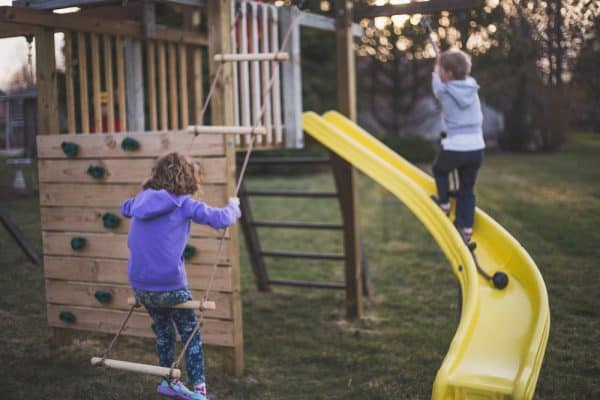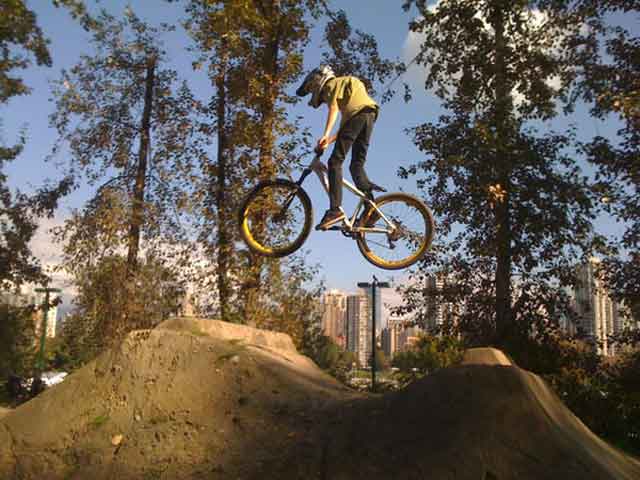It is more important than ever to encourage children to spend time outdoors. With the rise of indoor activities and screen time, children are missing out on the benefits of outdoor play.
As parents, it is our responsibility to create engaging and stimulating outdoor play spaces for our children. This article aims to guide you through the process of creating a DIY outdoor play space that will foster your child’s imagination and provide endless hours of fun and adventure.

Understanding the Importance of Outdoor Play
Outdoor play is not just about having fun; it plays a crucial role in a child’s development. It provides them with opportunities to explore their surroundings, sharpen their skills, and learn important life lessons. Here are a few notable benefits of outdoor play for children:
Benefits of Outdoor Play for Children
1. Physical Health: Outdoor play allows children to engage in physical activities such as running, jumping, climbing, and biking. This helps in developing their motor skills, improving coordination, and building strong muscles and bones.
2. Cognitive Development: Outdoor play enhances a child’s cognitive abilities. It stimulates their senses, improves problem-solving skills, and boosts creativity by presenting them with different natural elements and open-ended play opportunities.
3. Emotional Well-being: Being outdoors in nature has a positive impact on children’s mental health and emotional well-being. It reduces stress, anxiety, and feelings of restlessness, promoting a sense of calmness and happiness.
4. Social Skills: Outdoor play spaces provide children with opportunities to interact and socialize with their peers. It teaches them important social skills such as sharing, cooperation, communication, and conflict resolution.
The Role of Outdoor Play in Child Development
Outdoor play is not just a luxury; it is an essential part of every child’s development. It helps them develop physically, mentally, and emotionally. Here are some key ways in which outdoor play contributes to a child’s overall development:
1. Physical Development: Outdoor play allows children to engage in activities that promote gross motor skills development, such as running, jumping, and climbing. This helps in building strength, coordination, and balance.
2. Cognitive Development: Outdoor play stimulates a child’s cognitive abilities by presenting them with a variety of sensory experiences. They get to explore different textures, smells, sounds, and sights, which helps in developing their sensory perception and cognitive skills.
3. Emotional Development: Outdoor play provides children with a sense of freedom and independence. It allows them to explore their surroundings, take risks, and overcome challenges, which contributes to their emotional resilience and self-confidence.
4. Social Development: Outdoor play spaces offer children the opportunity to interact with their peers in a natural and unstructured environment. They learn how to cooperate, negotiate, and resolve conflicts, which are crucial social skills for their future.
5. Intellectual Stimulation: Outdoor play not only stimulates physical and cognitive development but also provides intellectual stimulation. Children are exposed to a variety of natural elements, such as plants, animals, and weather phenomena, which sparks their curiosity and encourages them to ask questions and seek answers.
6. Appreciation for Nature: Spending time outdoors allows children to develop a deep appreciation for nature and the environment. They learn about the importance of conservation and sustainability, and develop a sense of responsibility towards the natural world.
7. Imagination and Creativity: Outdoor play encourages children to use their imagination and be creative. They can transform a simple stick into a magic wand or a pile of rocks into a castle. This imaginative play fosters their creativity and helps them think outside the box.
8. Problem-Solving Skills: Outdoor play presents children with various challenges and obstacles that require problem-solving skills. Whether it’s figuring out how to climb a tree or building a fort with limited resources, children learn to think critically and find creative solutions.
9. Resilience and Risk-Taking: Outdoor play allows children to take risks in a controlled environment. They learn to assess risks, make decisions, and face the consequences of their actions. This builds resilience and helps them develop a healthy attitude towards risk-taking.
10. Unstructured Play: Outdoor play provides children with unstructured play opportunities, where they have the freedom to explore, create their own games, and set their own rules. This fosters independence, self-expression, and a sense of ownership over their play experiences.
As you can see, outdoor play offers numerous benefits and plays a vital role in a child’s holistic development. It is essential for parents, educators, and caregivers to prioritize and encourage outdoor play to ensure the well-being and optimal growth of children.
Planning Your DIY Outdoor Play Space
Creating a DIY outdoor play space requires careful planning and consideration. Here are some important factors to keep in mind:
Assessing Your Backyard Space
Start by assessing the available space in your backyard. Measure the area and consider the shape and layout. Take note of any obstacles or potential hazards, such as trees, rocks, or slopes, which may impact your play space design. Ensure that the space is large enough to accommodate the play structures you have in mind.
Once you have determined the size and layout of your backyard, it’s time to get creative! Consider the natural elements already present in your outdoor space. Are there any beautiful trees that can provide shade and add a touch of magic to the play area? Maybe there’s a small hill that can be transformed into an exciting slide or a gentle slope that can be turned into a mini climbing wall. Embracing the unique features of your backyard will not only make the play space more interesting but also help blend it seamlessly with the surrounding environment.
Choosing the Right Play Structures for Your Child’s Age
Next, consider your child’s age and developmental stage when selecting play structures. Younger children may benefit from swings, slides, sandboxes, and climbing structures, while older children may enjoy more challenging elements like rope courses, ziplines, or treehouses. Take into account their interests and abilities to ensure a play space that is both safe and engaging.
When it comes to choosing play structures, think beyond the traditional options. Incorporating natural materials like logs, tree stumps, and boulders can add an element of adventure and exploration to the play space. These natural elements not only provide a unique sensory experience but also encourage imaginative play and creativity. Imagine your child’s delight as they balance on a fallen log or hide behind a cluster of rocks, pretending to be on an exciting jungle expedition.
Furthermore, don’t forget to consider the importance of open-ended play. Provide spaces where children can engage in unstructured play, allowing their imaginations to run wild. This could be a simple grassy area where they can set up a pretend picnic or a corner dedicated to building forts with old sheets and blankets. By incorporating opportunities for open-ended play, you are fostering creativity and problem-solving skills in your child.
Essential Elements of a Backyard Play Space
Incorporating various elements into your DIY outdoor play space will enhance its appeal and provide a rich play experience for your child. Here are two key elements to consider:
Incorporating Natural Elements
Introduce elements of nature into your play space to create a more stimulating and engaging environment. Consider adding a garden, a water feature, or a small wildlife habitat. Encourage your child to explore and interact with these natural elements, promoting a sense of wonder and appreciation for the natural world.
Selecting Safe and Durable Materials
Ensure that all materials used in your DIY play space are safe and durable. Choose non-toxic paints, sealants, and materials that can withstand outdoor elements. Consider using recycled materials or repurposing items from your own home to add a unique and eco-friendly touch to your play space.
Step-by-Step Guide to Building Your Play Space
Now that you have planned your play space, it’s time to bring your vision to life. Here is a step-by-step guide to help you build your DIY outdoor play space:
Preparing the Ground
Clear the designated area of any debris, rocks, or vegetation. Level the ground and add a layer of playground-safe flooring, such as rubber mulch or synthetic turf. This will provide a soft and safe surface for your child to play on.
Constructing Play Structures
Follow the manufacturer’s instructions to assemble and install the chosen play structures. Ensure that they are securely anchored to the ground and meet safety standards. Double-check all connections and make any necessary adjustments to ensure stability and durability.
Adding Finishing Touches
Complete your DIY play space by adding finishing touches that will enhance the overall aesthetic and functionality. Install seating areas for parents or caregivers to supervise, add storage solutions for toys and equipment, and incorporate shade structures to protect against the sun’s rays. Consider adding colorful decorations or personalized touches to make the play space unique and inviting.
Maintenance and Safety Considerations
Once your DIY outdoor play space is complete, it is important to ensure its ongoing maintenance and safety. Here are some essential tips:
Regular Inspection and Maintenance Tips
Regularly inspect your play space for signs of wear and tear, such as loose screws, splintered wood, or damaged equipment. Repair or replace any worn-out or broken parts immediately. Keep the play area clean and free from debris, and regularly sanitize surfaces and toys to maintain hygiene.
Ensuring Safety in Your Outdoor Play Space
Ensure that your play space is designed with safety in mind. Install appropriate fencing to prevent unsupervised access, and use safety gates or locks if needed. Consider installing ground coverings that provide shock-absorption, such as rubber mats, to reduce the risk of injuries from falls. Regularly educate your child about the importance of following safety rules and guidelines while playing outdoors.
By creating a DIY outdoor play space, you are providing your child with a world of imagination, adventure, and discovery. It not only contributes to their physical and cognitive development but also fosters a love for nature and the outdoors. So, roll up your sleeves, involve your child in the process, and embark on a journey of creating a backyard adventure for your little ones. The memories they create in their outdoor play space will last a lifetime.



